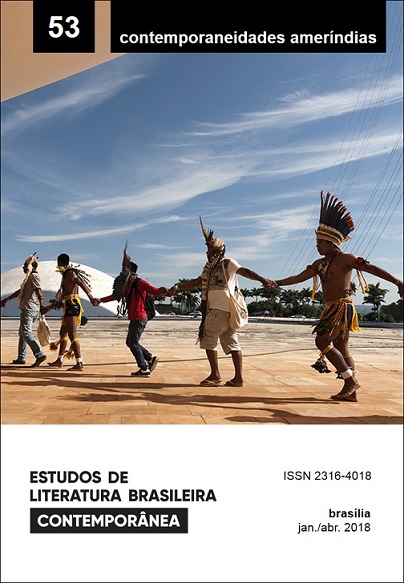Wenía: the emergence of the ancestors ”“
Reading and translation of an Amerindian narrative chant (Marubo, Amazônia Ocidental)
DOI:
https://doi.org/10.1590/2316-4018533Abstract
This work is composed by the bilingual translation of the myth-song Wenía from the Marubo, a Panoan-speaking people of Vale do Javari Indigenous Reservation, Brazil. The annotated translation, which presents the origins of Marubo ancestors, is preceded by an introductory essay on the conceptual problems involved in the narrative, such as metaphor, formulaic composition, classification and etiology, all of them essential to the understanding of Marubo's processes of ethnogenesis and shamanistic poetics.
Downloads
References
CASTRO, Eduardo Viveiros de (2002). A inconstância da alma selvagem. São Paulo: Cosac Naify.
CASTRO, Eduardo Viveiros de (2004). Perspectival anthropology and the method of controlled equivocation. Tipití, San Antonio, v. 2, n. 1, p. 3-23.
CESARINO, Pedro de Niemeyer (2006). De duplos e estereoscópios: paralelismo e personificação nos cantos xamanísticos ameríndios. Mana, Rio de Janeiro, v. 12, n. 1, p. 105-134.
CESARINO, Pedro de Niemeyer (2011a). Oniska ”“ Poética do xamanismo na Amazônia. São Paulo: Perspectiva; Fapesp.
CESARINO, Pedro de Niemeyer (2011b). Entre la parole et l’image: le systhème mythopoïetique marubo. Journal de la Société des Américanistes, Nanterre, v. 97, n. 1, p. 223-259.
CESARINO, Pedro de Niemeyer (Org.) (2013a). Quando a Terra deixou de falar ”“ Cantos da mitologia Marubo. São Paulo: Editora 34.
CESARINO, Pedro de Niemeyer (2013b). Cartografias do cosmos: conhecimento, iconografia e artes verbais entre os Marubo. Mana, Rio de Janeiro, v. 19, n. 3, p. 437-471. Coleção Narradores Indígenas do Alto Rio Negro. São Gabriel da Cachoeira: FOIRN. 8 v.
CUNHA, Manuela Carneiro (2009). Cultura com aspas. São Paulo: Cosac Naify.
DESCOLA, Philippe (2005). Par-delà nature et culture. Paris: Gallimard.
FRANCHETTO, Bruna (2003). L’autre du même: parallélisme et grammaire dans l’art verbal des récits Kuikuro (caribe du Haut Xingu, Brésil). Amérindia, Villejuif, n. 28, p. 213-248.
HEURICH, Guilherme Orlandini (2015). Música, morte e esquecimento na arte verbal araweté. Tese (Doutorado em Antropologia Social) ”“ Museu Nacional, Universidade Federal do Rio de Janeiro, Rio de Janeiro.
KATUKINA, Benjamin André; SENA, Vera Olinda (Org.). ([1997?]). Noke shoviti ”“ Mito katukina. Rio Branco: Comissão Pró-Ãndio do Acre; Poronga.
LATOUR, Bruno (1991). Nous n’avons jamais été modernes. Paris: La Découverte.
LÉVI-STRAUSS, Claude (1962). Le totemisme aujourd'hui. Paris: P.U.F.
LÉVI-STRAUSS, Claude (1949/1967). Les structures élémentaires de la parenté. Paris: Mouton & Co.
MELATTI, Julio Cezar (1977). Estrutura social Marubo: um sistema australiano na Amazônia. Anuário Antropológico, Brasília, n. 76, p. 83-120.
MUSSA, Alberto (2009). Meu destino é ser onça. Rio de Janeiro: Record.
RUEDAS, Javier (2001). The Marubo political system. Dissertatioin (Ph.D. in anthropology) ”“ Tulane University, New Orleans.
SÁ, Lucia (2004). Rain forest literatures: Amazonian texts and Latin American culture. Minneapolis: The University of Minnesota Press.
WELPER, Elena Monteiro (2009). O mundo de João Tuxáua: (trans)formação do povo Marubo. Tese (Doutorado em Antropologia Social) ”“ Museu Nacional, Universidade Federal do Rio de Janeiro, Rio de Janeiro.
ZUMTHOR, Paul (1983). Introduction à la poésie orale. Paris: Seuil.
Downloads
Published
How to Cite
Issue
Section
License
Authors who publish in this journal agree to the following terms:
a) The authors maintain the copyright and grant the journal the right of first publication, the work being simultaneously licensed under the Creative Commons Attribution License-Non Commercial 4.0 which allows the sharing of the work with acknowledgment of the authorship of the work and publication this journal.
b) Authors are authorized to enter into additional contracts separately, for non-exclusive distribution of the version of the work published in this journal (eg publish in institutional repository or as a book chapter), with authorship recognition and publication in this journal.
c) Authors are allowed and encouraged to publish and distribute their work online (eg in institutional repositories or on their personal page) after the editorial process, as this can generate productive changes, as well as increase the impact and citation of published work (See The Effect of Free Access).
d) The authors of the approved works authorize the magazine to, after publication, transfer its content for reproduction in content crawlers, virtual libraries and the like.
e) The authors assume that the texts submitted to the publication are of their original creation, being fully responsible for their content in the event of possible opposition by third parties.


